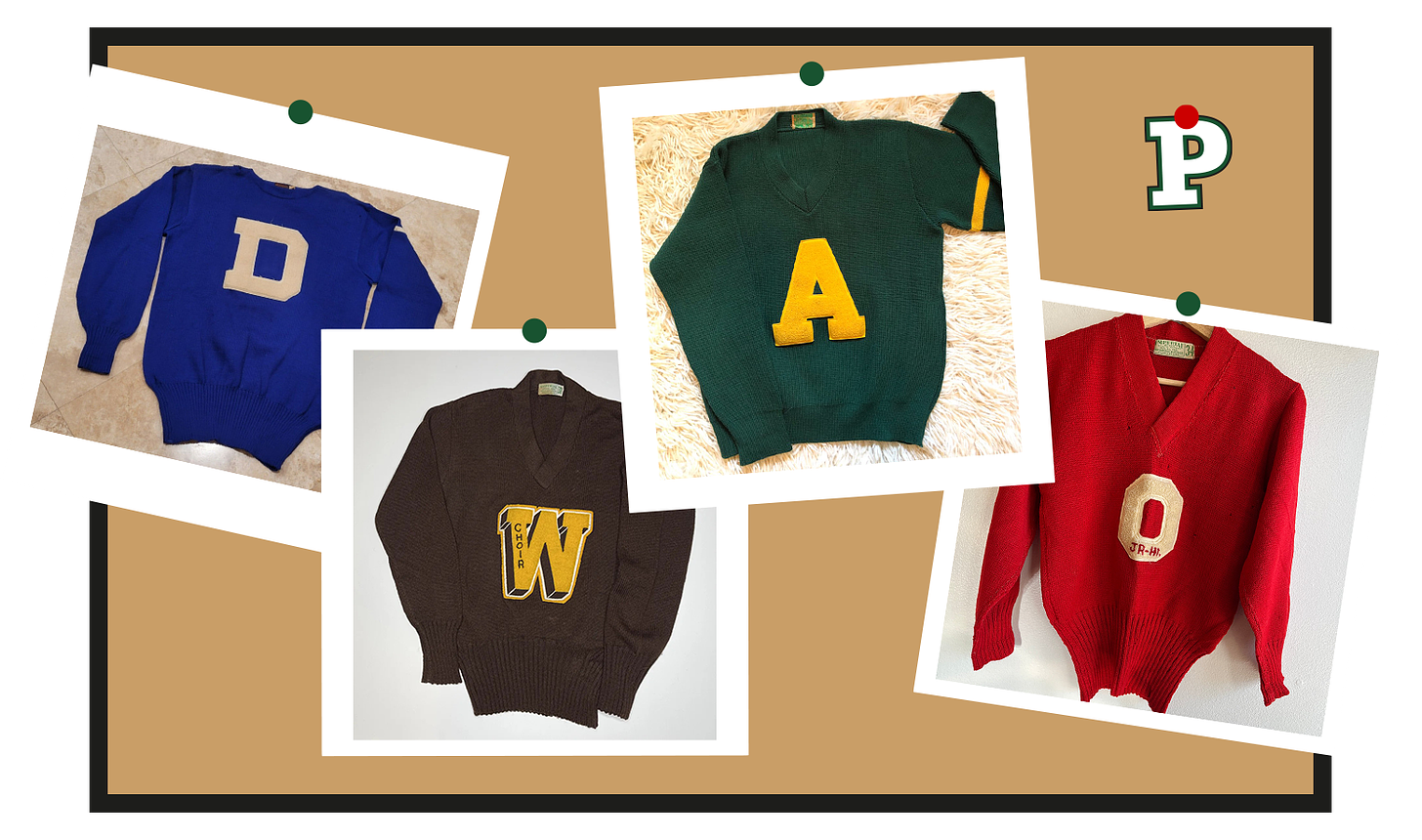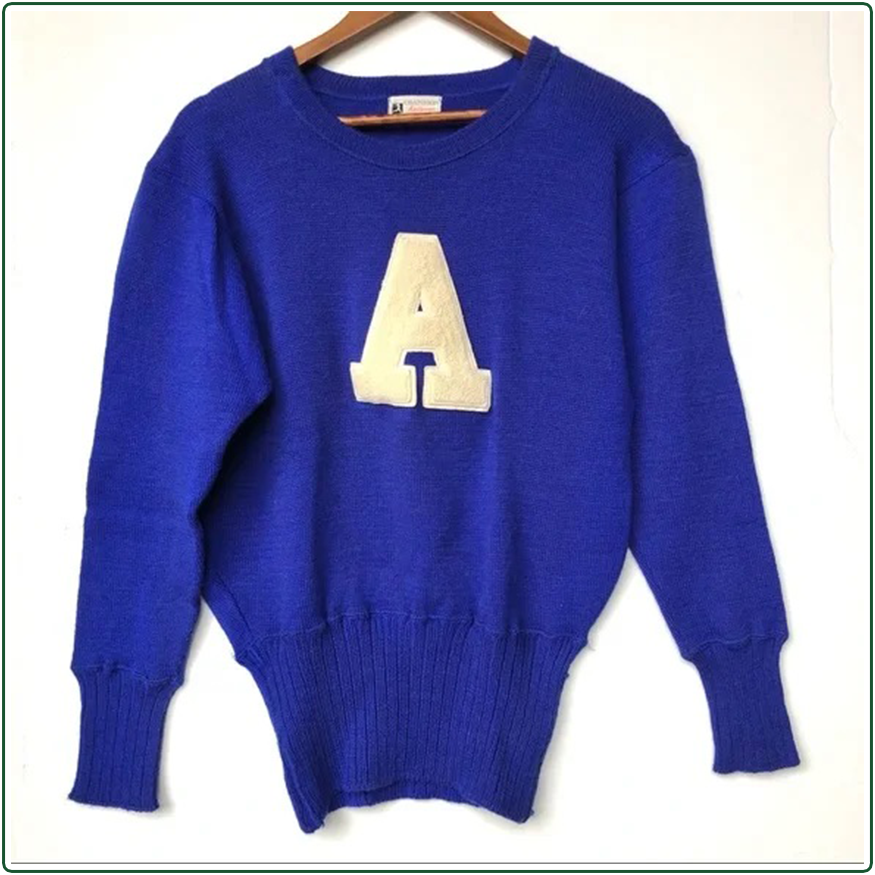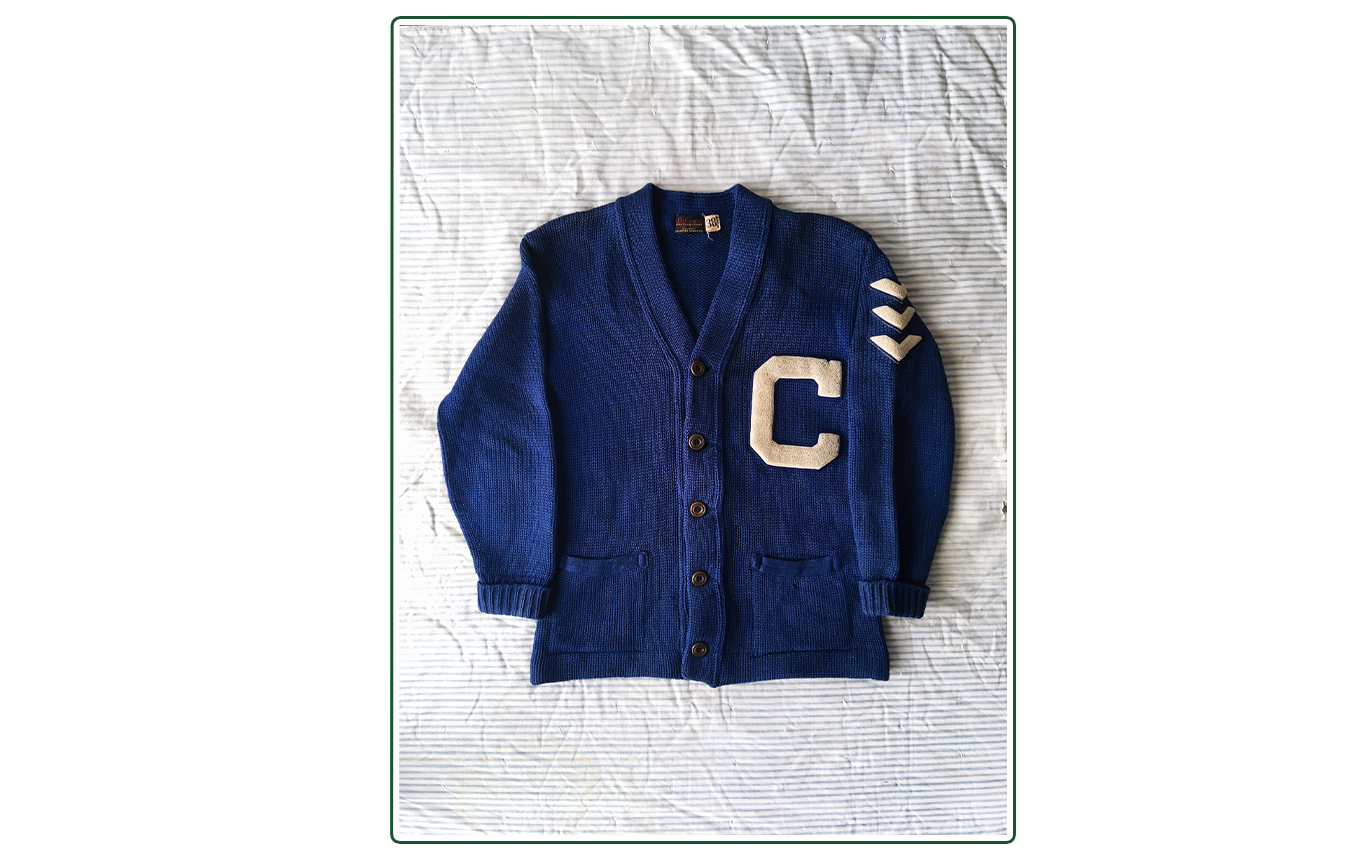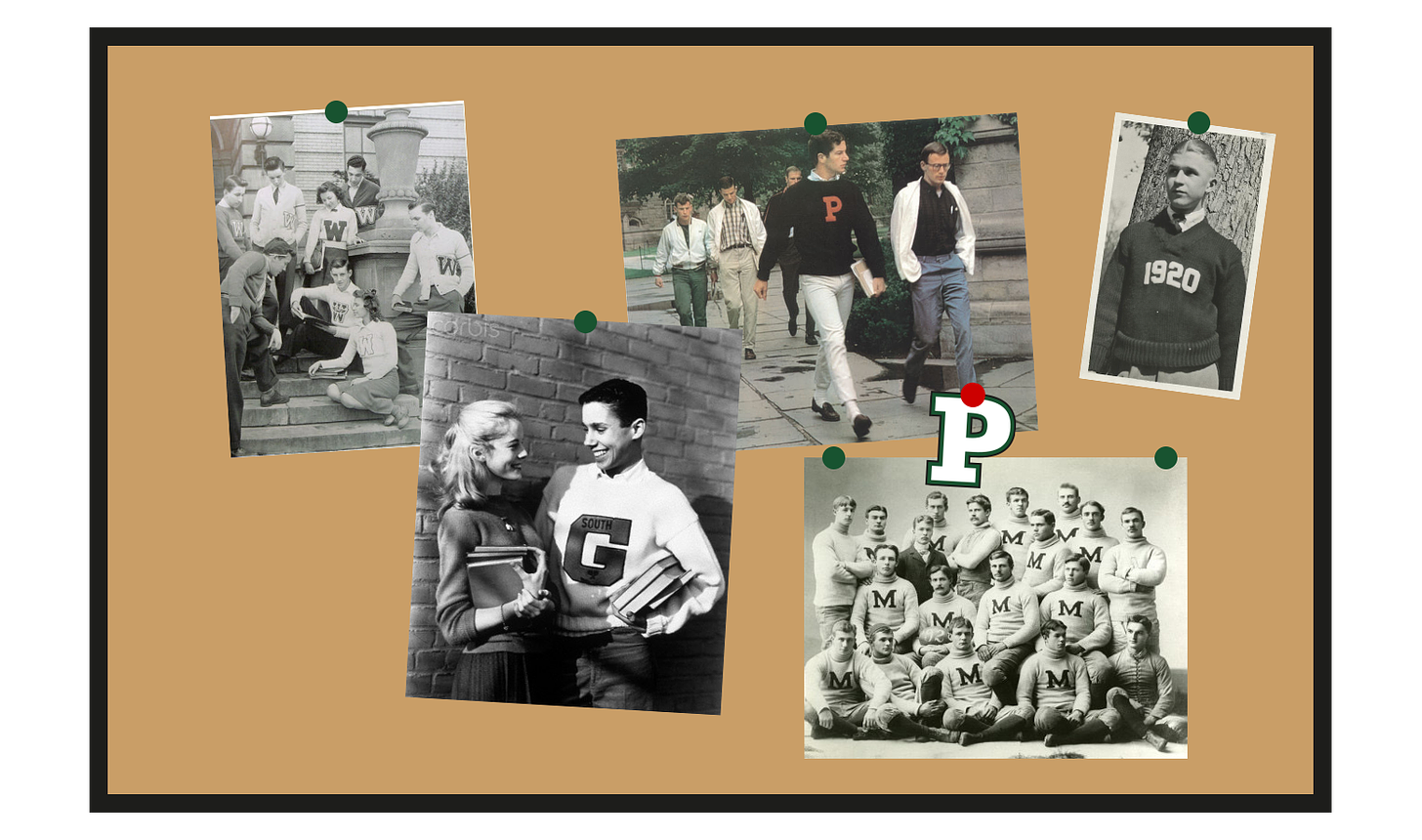Meeting #12: Vintage Varsity Knits, my Current Rabbit-hole
Dipping a toe into almost a century of bookstore pickups
Housekeeping
Starting March with some spring cleaning, coming up on half a year it was time to tidy up the club’s visual language a touch, I hope it isn’t found to be too jarring of a change, but I do think it makes for a better representation of the direction in which the club is headed. Something a little more thought out was in order, but I’ve been sure to pile on the pretence. Opinions are welcome as always.
Keep an eye out too for my upcoming Club Chair Bulletin, for some quick, light reading. This is a new regular column for the club in which I hope to share some ideas, garments and other recommendations that don't constitute their own articles.
That's all for housekeeping this week.
Vintage Varsity Knits
In the days before Champion Reverse Weave sweatshirts dominated the racks of college bookstores, lettermans and spell-outs came on gorgeous, 100% wool knits. In fact, this is where the big C brand got their start. They’ve hit my radar hard over the past couple weeks, vintage knitwear exists in a league high above anything on the market these days. I’d thought for today’s meeting to take a look at why one might look to purchase a vintage college knit or depending if you fall as hard as I have, start building a collection.
What are we looking at?
Pictured above are a few examples of the sort of thing we’re talking about here. 100% wool jumpers with chenille letters, numbers, and sometimes stripes or chevrons stitched onto them, (what the hell is chenille?) Letters are representative of the college from which they came, of course, numbers will be either competition numbers or varsity years, stripes and chevrons indicate number of years on varsity, use this to ensure you only buy vintage knits owned by alpha, veteran dead college athletes who got on the team every year.
On that note though, these were athletic wear, wool’s natural breathability and moisture absorption means they functioned pretty well, the persistence of the cable knit in cricket is testament to knitwear’s place on the sporting ground. However, this does mean a lot of them are going to be a little worse for wear, as always with vintage, do your due diligence, know where to check, be prepared for odd smells.
Whilst examples can be found from as late as the 80s, the best options are 40s-60s. There are bargains to be had, but those who know what they’ve got run up the prices.
So why would one want one?
#1: Nothing fits like vintage knits
Look at these knits above, note the drastic taper into the large lower rib, note how short they are. These don’t look like much of the knitwear made today, just in silhouette. As a result, they don't fit like them either. That big rib, when worn with wide leg trousers, functions to build an athletic structure to an outfit, and the length, dare I describe it as cropped in consideration of the modern lens, speaks to a time when it wasn’t just us insufferable style lot who had their pants up high. Yet, whilst wearing pieces this old can at times communicate a sense of perhaps over-construction, a sort of cosplay, I would posit that theses sweaters keep about them a modernity which stops them from feeling dated, especially when compared to era-identifying patterns for which vintage knitwear is often known.
#2: Incredible intrigue capacity
These knits have been placed under MAXIMUM RISK OF COLLECTION STARTING for the time being, for the sake of my finances I’m keeping purchases on a strict lockdown. The reason for this is the extensive capacity for story to be woven into these clothes, the opportunity for questions: who owned this? what college did they attend? what sport did they play? were they any good? Whilst anything that old is going to carry a certain amount of intrigue, the unique ties that varsity knits have to a specific place, at a specific time, details which are immediately apparent just from looking at the garment itself, are serious catnip to the ivy obsessive.
Also within consideration of intrigue is the variety, considering a wide selection of colour, lettering, style, neckline. It seems like it might only be right to have one of each, a cardigan, crew-neck, v-neck, slash-neck even? Whilst I have to admit I’ve been beguiled by these things, the anti-consumerist in me still keeps me from becoming a collector just yet.
It is nice at times, when a catalyst for the analysis of one’s taste, as this is, comes about, to dive little further into why we care. What is the nature of narrative within clothing ownership? The academic might tell us it is to do with cultural capital, but I think there is something internal too. A feeling of specialness in taking charge not only of the garment but of the narrative, choosing to keep it to oneself simply as a sense of fulfilment.
#3: Certified prep classic
The letter sweater is a garment which sits at the heart of Ivy, it represents the sporting infusion which persists through the style to this day. It sits alongside the OCBD as a founding piece, predates the widespread adoption of khakis. Whilst many other garments within the Ivy canon stretch into other styles, the varsity knit functions essentially as a neon sign identifying one’s intention to communicate the Ivy style. Sure, it isn't subtle, but then Ivy wasn’t ever meant to be.
How are we wearing them?
Styling capacity will be governed, to a certain extent, by colour choice. Their existence as sportswear means loud, solid colours make up the majority of examples. As such we’re perhaps classically looking at pairing them with neutrals, chinos as the obvious choice, maybe some tweed for a Drake’s style colourful flare. Maximising the silhouette that these old styles offer is a priority, so as to best exemplify the piece. What it is we are looking at, really, is that of a hero piece when constructing an outfit, something which demands attention, one must not be afraid of drawing such attention.
Opt for an Oxford shirt or heavy tee in white underneath, especially if the lettering is in white chenille, for some very nice, subtle cohesion. Even if the lettering is not white, there tends to be some white somewhere on the garment, and even if there isn't, white is a nice pick to avoid clashing with bold team hues.
The cardigans are an interesting one, now which I’d like to position as an alternative to the better known letterman jacket, perhaps with less of the high-school bully, dude-bro connotation, with the consideration that letterman jackets are a rich garment in their own right. The cardigan ought to pair very nicely with a shirt and tie, and can be layered under a blazer, where a letterman jacket has to go overtop.
How does one acquire them?
Whilst there are some reproductions and approximations, we’re looking at picking up vintage clothing here. Proper vintage, up to ninety years old vintage. This is a bit trickier than picking up some little e 501s. Firstly, one is likely to be looking online, from specialist sellers on second-hand platforms, or with big blanket searches. There’s also the point of condition, as aforementioned, these were sportswear, so they got ridden hard and put away wet at times, paying good attention to photographs, and requesting more if those on the listing are inadequate to complete a full assessment, should be on the agenda.
As for how much to pay, I’ve seen listings as low as twenty and as high as five-hundred, depending on condition and provenance. Thirty to sixty seems like a reasonable ball-park for me, perhaps stretching up to a hundred, if the ideal piece comes along, in order to be getting a knit in good condition.
Labels are not something which warrants much attention, they tend to be local knitting mills or houses that have since faded into memory. So long as you’re looking at something 100% wool quality can be expected, hell its lasted this long.
Varsity knits are iconic Ivy wear, but they come with a slight barrier to entry. I am forever wary of describing pieces as “essential” in relation to this. No piece of an Ivy wardrobe is essential, other than an interest in the style. Be careful though, because an interest in the style might cause you to fall down a rabbit hole.









